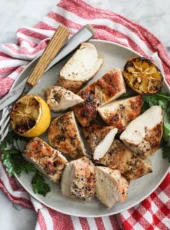Fresh garlic, a homemade pickling spice blend, and fiery chili peppers combine in this straightforward, classic homemade dill pickle recipe, imparting an irresistibly bold and zesty flavor.
Every summer, I eagerly plan to jar a few batches of piquant garlic-infused pickles, aiming to match the unforgettable taste of a jar I stumbled upon at a local farmer’s market—a taste that left me utterly amazed and puckered. As a self-proclaimed pickle enthusiast, my affection for pickles knows no bounds. This spicy pickle recipe, a testament to my pickle-loving devotion, embodies everything I adore in a spicy pickle: garlic, dill, a hint of heat, and an abundance of crunch. It’s fashioned from a recipe I discovered during NPR’s All Things Considered Lost Recipe series, where a listener sought to recreate her Aunt Minnie’s covert pickle formula, presenting NPR with only a handful of details. To decode the recipe, NPR sought counsel from Marisa of Food In Jars, an expert in the realm of canning, who generously shared invaluable insights into pickling, serving as the foundation for this homemade dill pickle recipe.
What’s in This Dill Pickle Recipe
This dill pickle recipe packs a punch with the addition of garlic and Thai chili peppers in the pickling brine, offering a delightful spicy kick. These pickles are incredibly adaptable to suit your preferences—whether you opt to can them for long-term storage or prepare them as refrigerator pickles for quicker consumption. Feel free to omit the chili peppers if you prefer less heat. Adjust the cucumber size to fit, or intensify the garlic flavor by adding more—or exclude it altogether.
The ingredients for this dill pickle recipe are:
– Pickling cucumbers
– Apple cider vinegar
– White vinegar
– Water
– Pickling salt
– Dried dill weed (not fresh dill)
– Thai red peppers or other spicy chilies like habanero
– Garlic cloves
– Homemade pickling spice blend (ingredients listed below)
What Type of Cucumbers Are Best for Pickling
For quick or refrigerator pickles, opt for thin-skinned cucumbers such as regular garden cucumbers, Persian cucumbers, or seedless English cucumbers. These varieties readily absorb the vinegar solution. For canning, choose sturdier cucumbers with thicker skin like Kirby cucumbers, ensuring they retain their crispness after brining.
Which Vinegar is Best for Dill Pickles
While various vinegars have their merits, distilled white vinegar is ideal for dill pickles due to its mild aroma, flavor, optimal acidity level, and clear color that won’t alter the appearance of the pickles. I use a blend of half cider vinegar and half white vinegar for a tangy, puckering effect.
How to Make Dill Pickles
First, prepare the pickling jars—wide-mouth mason jars are indispensable for canning pickles. If canning, sterilize the jars and lids either by dishwasher or boiling in a large pot of water. If not canning, simply wash and rinse the jars and lids in hot water.
Trim the ends of the cucumbers before pickling, ensuring to rinse them thoroughly and trim the blossom end to prevent spoilage. If unsure, trim both ends for added caution. Keep the cucumbers whole or slice them into spears or coins while keeping the skin intact.
Pack the Pickles
Pack the jars with a few tablespoons of pickling spice, dried dill, Thai red peppers, and garlic cloves before tightly fitting in the cucumbers (whole or sliced) to ensure they remain intact.
Add the brine—simmer the vinegar, water, and salt in a stockpot, then pour the brine over the cucumbers in the jars, leaving about ½ inch of headspace.
How to Can Pickles
Prepare a canning pot with boiling water, ensuring sufficient space to accommodate the jars without overflowing. Wipe the jar rims and place sterilized lids and rings atop the jars.
Process the jars in a canner water bath for 10 minutes. Once done, remove the jars and allow them to cool on a counter.
Ensure that the lids pop down, indicating a proper seal. Refrigerate any jars that do not seal for immediate consumption as refrigerator pickles.
At what point does a cucumber become a pickle? Allow the pickles to sit for around 10 days for optimal flavor development, though some prefer waiting up to 3 months—a testament to their enhancement over time.
[Image Placeholder 8: Image portraying refrigerator pickles or labeled jars in the fridge]
Can I Make These as Refrigerator Pickles?
Yes! For refrigerator pickles, skip the hot water bath and directly place the jars in the fridge. Although not shelf-stable for as long, they will last in the fridge for 1-2 months.
How Long Are Homemade Canned Dill Pickles Good For?
Store these pickles in a dry, cool place—they improve with time and can be stored for up to 1 year. Remember to refrigerate any opened jars.
10












